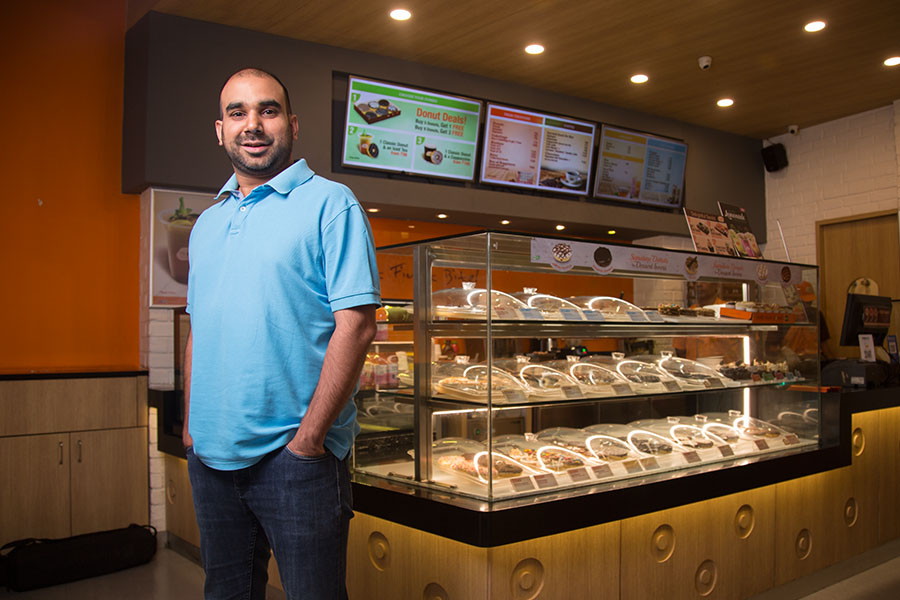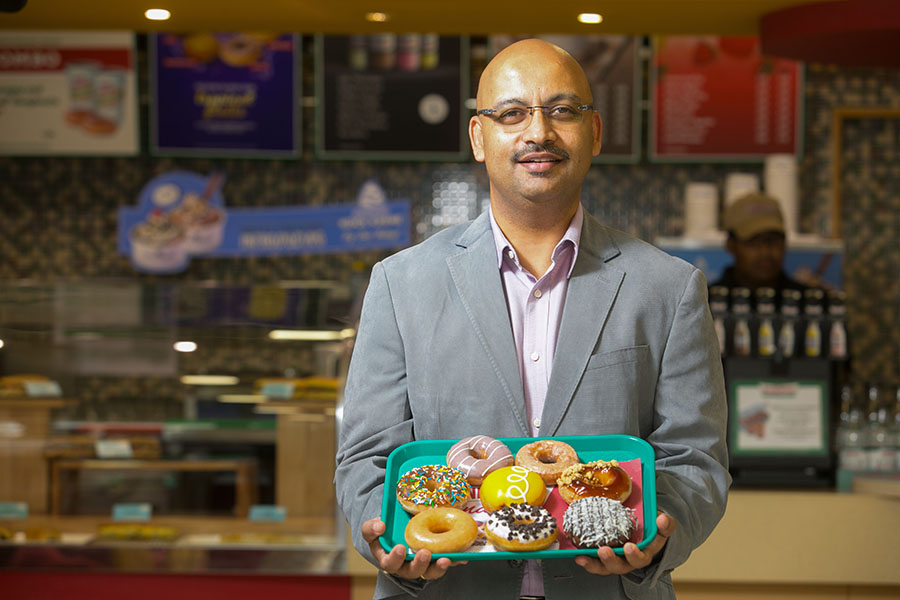
Making dough from doughnuts
For the three biggest doughnut brands in India, creating a niche market has been a mixed bag of experiences

Lokesh Bharwani- founded Mad Over Donuts has 50 outlets across four cities in India
Image: Joshua Navalkar
When Lokesh Bharwani started Mad Over Donuts in 2007, memories of his college days were still fresh in his mind. “Doughnuts were a part and parcel of everyday life in the United States,” he says, having studied at Babson College in Massachusetts, returning to his native Singapore in 2004. “But it was almost non-existent in the Asian market.”
Following Bharwani into India were two global food retail giants, Dunkin’ Donuts and Krispy Kreme; both brands came from the US, where doughnuts-and-coffee is considered a quick breakfast on the way to work or college.
In 2012, when Massachusetts-based Dunkin’ Donuts set up shop in India, in partnership with Jubilant FoodWorks, it aimed to set up 100 stores over five years. Similarly, when North Carolina-based Krispy Kreme teamed up with Citymax Hotels (India) Pvt Ltd and Bedrock Food Co Pvt Ltd in 2012, it wanted to have 80 franchised outlets across India in the next five years.
Cut to 2017. Dunkin’ Donuts has managed to open only 59 outlets in 11 cities, and Krispy Kreme has just 26 in three, while Singapore-based MOD has 50 outlets across four cities in India. Like with store count, revenues too have been slow to grow. (The companies refused to divulge exact numbers.)
And in the last five years, the three biggest players in the doughnut market have had—as international food retail biggies such as McDonald’s did before them—their share of learnings.
The first, and most important, is that Indians have not taken to doughnuts the way Americans have—as a breakfast staple. The breakfast preferences of Indians—even those that are eaten standing up, and within minutes—are more attuned to traditional and more filling fare, rather than a single doughnut. “In the West, doughnuts are more of a habitual consumption, whereas in India, it is still largely an impulse item,” says Pratik Pota, CEO of Jubilant FoodWorks. “Secondly, in the US, most of the doughnut sales happen before noon, whereas it is the opposite in India.” Apart from doughnuts, Dunkin’s international menu comprises items such as bagels, muffins, croissants and flatbreads, while the one they now have for India largely comprises burgers, which is more an all-day meal option rather than a breakfast option. Krispy Kreme, the last of the three brands to set up shop in India, has not started any breakfast offering as it believes the market for morning meals is still small.
The second set of lessons is from their attempts at Indianisation. Following in the footsteps of pizzas and burgers, some doughnuts went egg-free, and others took on desi flavours: Krispy Kreme launched vegetarian doughnuts, while Dunkin’ Donuts launched flavours including coconut rasgulla, petal gulab jamun and motichoor laddoo. But these variations did not do what the Chicken Maharaja Mac—the beef-free version of the Big Mac—or the McAloo Tikki had done for McDonald’s.

Image: Selvaprakash Lakshmanan for Forbes India
“When Krispy Kreme decided to Indianise the doughnut by merging the mithai with it—such as the gulab jamun doughnut or the halwai doughnut—consumers didn’t accept it,” says Vishal Kapoor, president, Citymax Hotels (India), an arm of the Dubai-based Landmark Group. “They like an international experience and we stick to that.” MOD’s Bharwani agrees, and says that doughnuts are universal, and don’t need to be tailored to local tastes.
Also, consumers in India don’t walk into stores for doughnuts alone—they want more. “Sometimes doughnuts are fine, sometimes they need food,” says Pota, after observing customer demands at Dunkin’ Donuts. “So our portfolio is a combination of doughnuts, beverages and conventional food items like burgers.” MOD, too, has diversified its offerings to include cookies and waffles, and soon-to-be-launched savouries.
Operating in India has also been a journey of discoveries. “We sell more beverages here than anywhere else in the world,” says Kapoor. “Globally, beverages constitute 15 to 20 percent of sales, whereas, in India, the share is 30 percent. This is why we have innovated with drinks a lot more in India.” The company offered filter coffee on their menu right from the start, and this continues to be a hit; the latest innovation in milk shakes is also very India specific.
MOD found out that Indian consumers like their doughnuts warm. “From my weekend store visits, I learnt that consumers like the doughnut to be served warm,” says Tarak Bhattacharya, COO of Mad Over Donuts. “Until then, we would serve them cold.” Pota, of Jubilant FoodWorks, says that while the West prefers glazed doughnuts, chocolate is a huge favourite among Indian consumers. Dunkin’ Donuts also realised that while it is the leader in the US coffee market—it is considered a rival to Starbucks in that country—in India its largest share of revenue comes from doughnuts, and not coffee.
One of the biggest learnings, however, has been the optimal size of stores and outlets. “When we initially entered India, we thought we will launch just hub stores [they include kitchens]. Our first four stores had three kitchens,” says Bharwani of MOD. “But we realised very soon that they will not be viable. Today our ratio of hub stores to satellite stores is 1:9. That has helped store economics.”
Krispy Kreme, too, had aimed big, with initial plans to have three-fourth of their stores between 500 and 1,400 sq ft and the rest between 3,500 and 3,800 sq ft. Of its 26 outlets, three are hubs and two kiosks, while the rest are stores in malls and shopping neighbourhoods, with sizes between 200 and 500 sq ft for small stores, and 1500-2500 sq ft for large stores. Pota says, for Dunkin’ Donuts, “We are seeing that having kiosks and smaller formats, which combine doughnuts with minimal food and coffee and beverages, seem to have more promise to move forward.”
“We had opened express stores, which are just for takeaways [with no seating],” says Bharwani. “That was a learning for us, because we were pretty aggressive about it. It worked excellently for a while, but we realised that people want to sit, and they need some level of convenience, even if it is grab-and-go. We corrected this and have got the model right now.”
Although the start has not been ideal, the game has just begun. And, to be fair, other global quick-service-restaurant (QSR) players—McDonald’s, KFC, Domino’s and Burger King, to name a few—have had their share of adjustments and experimentation before settling into the Indian market. After all, urban Indians didn’t always eat burgers either.
Doughnut chains are just a small part of the $3.1 bln chain QSR segment
Doughnut chains form a small part of the rapidly expanding QSR category of the $45 billion (around Rs 3 lakh crore) food retail market in India, says Anurag Mathur, partner and leader, retail and consumer, PwC India; the chain QSR segment is worth $3.1 billion, and is expected to grow by 26 percent every year till 2020.
Doughnuts are an alternative to traditional sweets in India, says Mathur, adding that “doughnut stores are located in areas where the typical sweet shops do not have a presence, like in office complexes or inside malls. This is one of the main reasons for the doughnut brands doing well in India.”
And although the doughnut chains may not be in the same league as the local halwai, they are trying to make room for themselves in spaces dominated by traditional sweets. Gifting, for instance. “There is a growing sentiment that giving conventional mithai doesn’t appeal to the young,” says Pota. “Doughnuts therefore become a good contemporary gifting option.” Similarly, Bharwani highlights their box-of-12 as a great option for gifting.
But whatever the marketing strategies, the growth path ahead now looks more sober and measured than it did a few years ago. “Krispy Kreme started with a bang; we saw queues outside our stores when we started any new store,” says Kapoor. “2014 also continued well, with single-digit growth. 2015 was a good year for overall store growth, but bad for same-store growth, as we saw double-digit negatives. 2016 continued with single-digit negatives. 2017 is showing single-digit positives on same store growth.”
“We want to make sure we invest in expanding the market in these towns, create the right scalable growth model on the basis of our learnings, and then look at expanding in other markets,” says Pota whose Jubilant FoodWorks now aims to open four or five Dunkin’ Donut stores in the next year. “But given the nature of the category, we would be focussed on the larger markets before going to smaller ones.” Explaining this cautious approach, he adds that while there has been market penetration, the frequency of consumption is still not high. “Yes, awareness levels have increased, experience and trial of the category has increased. But the overall size of the category remains small, and the inflection point is yet to come. So the objective is to invest in expanding the category and ensure that consumers experience doughnuts.”
“When we started, we had to create the category for doughnuts,” says Bharwani, whose business remains family-owned. “But it is still a long way before it becomes mainstream.”















